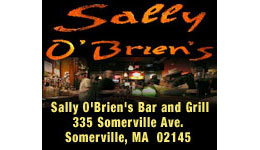After Somerville Police officer Timothy F. Donovan was struck and killed by a driver on the old Northern Artery Bridge, his sacrifice went officially unnoticed for decades.
But 65 years after his death, with help from the son of one of Donovan’s pallbearers and a Somerville cop with experience in getting fallen officers recognition years after their demise, Donovan’s name will be added to a Washington, D.C. memorial that honors officers killed in the line of duty.
Jack Tanner’s father, John, was a Somerville Police officer and a friend of Donovan’s. Growing up, Tanner said he heard stories of Donovan’s death. Donovan, he said, had been killed by a drunk driver while working at the scene of a traffic accident. For years, a picture of Donovan stood on the mantle of Tanner’s childhood home. He said Donovan’s wife, Helen Catherine Donovan, was a frequent visitor to his family’s house.
So it vexed him when he didn’t see Donovan’s name on a Web site listing American officers killed in the line of duty. The only Somerville officer on the list was Michael Dowd who, on June 12, 1947, was shot and killed by a tall, slim man behind a liquor store at 349 Highland Ave.
The killer, covering his face with one arm, said “Stick ‘em up” and fired a shot into Dowd’s abdomen on his left side, according to a police report of the incident. The shooter ran down Willow Avenue and was never caught.
“I wondered why Donovan wasn’t on there and that was the start of what became a five-year project, “ Tanner said.
Tanner contacted then-Acting Police Chief Robert R. Bradley who referred him to Captain John O’Connor. Two years earlier O’Connor had researched the case of Henry Lord, a Somerville police officer killed in World War 2. He successfully lobbied for a square dedicated to Lord at the corner of Cameron and Holland streets. But when it came to Donovan, O’Connor was initially stumped.
“I didn’t know when, where or anything about [Donovan’s death],” he said. “I put it in the corner of my desk and kind of forgot about it.”
But after a few more calls from Tanner, O’Connor became inspired. He needed to find the date of Donovan’s death before he could do anything else. He spent hours at the library looking through old newspaper archives (“I felt like I may go blind from that microfiche,” he said) and whenever he had the chance he would go to the basement of the police department and scour old, daily police logs from the period he believed the accident occurred.
“It was a mystery I wanted to solve and it became a hobby for me,” O’Connor said. “It was wrong that this guy had died for his community and was never given any recognition for it. It was a wrong I thought we may be able to right.”
Along the way, O’Connor said he spent “hundreds of hours” searching for a clue and chased down some false leads, including one case where an officer named William Donovan died after having brain surgery in 1950. Convinced this was his Donovan, O’Connor said he didn’t realize he had the wrong guy until weeks later.
But he kept searching. And one night as “my girlfriend began to tell me enough was enough, eureka! I found it,” he said.
O’Connor had found the daily police log from Nov. 14, 1942, and learned Donovan had been killed the day before on Nov. 13. Now with a date of death, O’Connor and Tanner found the front page of that week’s newspaper and submitted the documents to the National Law Enforcement Officers Memorial last Fall for consideration.
Last week O’Connor and Tanner learned Donovan’s name will be formally dedicated at the memorial in Washington D.C. on May 13 during National Police Week.
Captain Paul Upton said the memorial honors the approximately 160 to 170 police officers killed in the line of duty each year and another 100 from previous years whose deaths had been overlooked.
Tanner said he was happy to learn his father’s friend would finally get the recognition he deserved.
“It was a long time coming but we got it done,” he said.
















Reader Comments